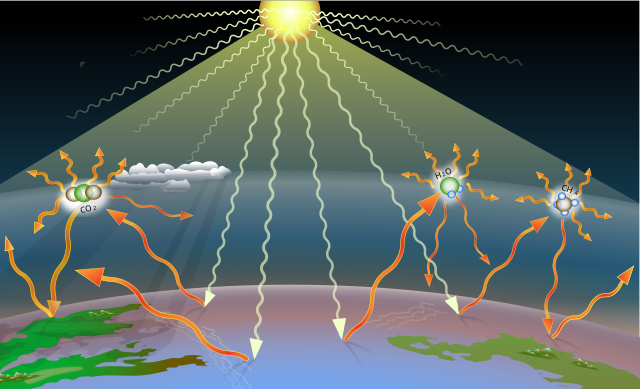In the last Earthward (Jan. 1), I suggested that a conflict of values explains why healthy-climate advocates don’t always speak with one voice. Advocates who most value preserving the integrity of the biosphere for future generations (intergenerational equity) naturally focus on the very long-term legacy effects of carbon dioxide in the atmosphere. Conversely, advocates motivated by environmental justice concerns (social equity) often emphasize the potent impacts of short-term heating from methane emissions. In this post, I’ll expand the inquiry by looking at this values divide through the lens of a contested idea in climate policy circles: net zero emissions. This idea is accepted by intergenerational equity advocates and strongly contested by climate justice groups.
The net zero emissions concept has been around in scientific circles for decades, but has reached public awareness only in the past half-dozen years, after roadmaps for the renewable energy transition began to emerge. The basic idea is this: the models show that limiting the global temperature increase to under 2°C requires extremely fast reduction of greenhouse gas emissions, yet some parts of the economy, like agriculture and heavy industry, cannot be rapidly decarbonized. Therefore, it is necessary to balance out the remaining emissions from these sectors by actively removing some carbon dioxide from the atmosphere. The “net” in “net zero emissions” refers to this carbon removal requirement.
How much carbon dioxide will need to be removed to stabilize the climate below a 2°C rise compared to preindustrial temperatures, and by when? Today, humans are emitting about 40 billion metric tons (40 Gt) of CO2 per year into the atmosphere. The climate models show that we can meet the 2°C target by reducing emissions 80-90% within three decades, while taking care of the remaining 4-8 Gt through some combination of new and existing carbon removal approaches. At that point, sometime in the 2050s, we would need to continue to remove that 4-8 Gt each year; if we can remove more than that, we enter the territory of “negative emissions.” That means deliberate drawdown of CO2 levels, perhaps to below the present-day 425 parts per million, or even lower.
The net zero emissions concept thus emerges from modeling that is broadly accepted by the climate science community. True, there are some built-in assumptions, informed by experts’ insights into how our industries work: some emissions can’t be prevented because we lack the technology to do so and there are no cost-effective alternatives. There are also uncertainties in the climate models, requiring that they be run many times by different groups, who explore many more assumptions to yield a range of plausible results. Do these scientific uncertainties explain the rejection of “net zero” by climate justice groups?
For the most part, the answer is no. Healthy-climate advocates emphasizing social equity and a just transition do not reject the basic principles of climate science. Rather, their concern is with the potential for the net zero emissions concept to be misused in ways that could prolong the life of the fossil fuel industry, perpetuating the social injustices endemic to our existing energy system.
There are two key issues. First, “net zero emissions” focuses on the carbon removal aspect of climate policy, and so has the potential to divert attention away from the immediately urgent need to replace fossil fuels with carbon-free energy. Second, recognition of the eventual need for large-scale carbon removal technologies is giving birth now to many new technology ventures and policy ideas for both direct removal of atmospheric carbon dioxide, and mitigation of emissions by capturing the CO2 emanating from industry smokestacks.
Proponents from both sides of the healthy-climate advocacy community agree on the danger posed by diverting attention away from immediate emissions reduction, and are united in the need to address it. They often sharply disagree, however, on whether to support the new business of carbon removal. This is the root of the climate advocacy divide.
Let’s first take a moment to look at how all engaged advocates can unite to address the first issue. One way to emphasize the urgency of immediate emissions reduction is to point out how far away our current technology is from the 4-8 Gt of carbon dioxide removal that the models say will be required by mid-century. Presently, we are capturing only about 0.1 Gt of CO2 per year worldwide. Almost all of this is capture from industry smokestacks, and almost none is as yet getting permanently sequestered by injection into deep geologic formations a mile or more underground. True, global emissions are finally nearing a plateau – but every year in which we do not sharply reduce emissions effectively increases that 4-8 Gt atmospheric capture requirement to higher and higher values.
We can also point to the increasing damage of extreme weather fueled by climate change. The horrific wildfires in Los Angeles have the potential to catalyze a broad new resolve and urgency to act, if only because the threats to the insurance industry in California and elsewhere have enormous economic ramifications. And what we’re seeing now is just from 1.3°C of temperature rise. Failure to immediately and sharply reduce emissions is going to make things significantly worse.
What about the second issue, that divides climate advocates? Advocates focusing on the integrity of the biosphere for future generations generally take an all-of-the-above approach that is accepting of incremental solutions. If we are not able to immediately eliminate natural gas, let’s capture the CO2 emissions while working to minimize methane leaks. If we still need oil for plastics and chemicals, at least we can reduce drilling by getting some from sustainable biomass. And if atmospheric carbon removal is not where we need it to be, then let’s invest in research to make it happen as soon as possible.
This worldview is grounded by faith in science and technology and, crucially, on the belief that we can solve climate change from within the business-friendly economic and political system that we have. It rests on sound science: because of the longevity of carbon dioxide in the atmosphere, the climate damage wrought is, to a good first approximation, simply dependent on the amount of CO2 emitted. Where there are opportunities to reduce these emissions, we must therefore exploit them.
But this perspective, which seems self-evident to many advocates like myself, is viewed with disdain, if not outrage, by those whose primary concern is climate justice. Climate justice is part of the ideological movement for social justice, which holds the core belief that the existing political and economic frame is fundamentally unjust. The fossil fuel industry is a fount of this injustice, but other technologies, to the extent complicit in perpetuating this system, may also be part of the problem. “Compromise with the enemy” is not acceptable, so incremental solutions like carbon capture that appear to sanction continued use of fossil fuels are deemed unacceptable.
If there are healthy-climate advocates who do not recognize the injustices pointed to by those emphasizing social equity, I haven’t met them in the many years I’ve been engaged. There is wide recognition that environmental justice communities are bearing a disproportionate share of the climate change damage, and broad agreement that their needs must be addressed.
The question I’m raising, though, is about climate and energy policy. The energy transition roadmaps reflect the best science we have to meet the challenge within the present political and economic frame – including the net zero emissions concept, however problematic. If climate justice advocates reject “net zero emissions” or other key elements of this mainstream approach, and oppose technologies that reduce emissions only incrementally, will it still be possible to keep warming below 2°C? Or are these advocates right to argue that current policies (like carbon capture) that mitigate the impacts of fossil fuels without fully eliminating them are not solving the problem, but leading us down a royal road to ruin?
In upcoming posts, we’ll explore that question by further unpacking the “net zero emissions” concept, and by looking at some specific policy areas where advocates disagree. Stay tuned.

